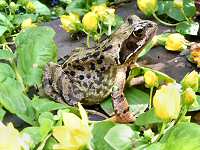Two years ago I replaced the garden pond I had inherited with a bigger one in a different part of the garden. I didn't do this without some concern about how the former pond's frog population would react to the change.
 One of the frogs (Rana temporaria) which have elected to spend their summer in the vicinity of the new pond.
One of the frogs (Rana temporaria) which have elected to spend their summer in the vicinity of the new pond.
Well I really needn't have worried. Before I had even removed the old pond, some of the garden's frogs had decided to breed in the new one, managing to produce a good quantity of spawn which I supplemented with the spawn laid in the old pond before I removed it (see diary entries for
20th March 2003 and
23rd March 2003). Unfortunately, perhaps due in part to the attentions of a heron (
Ardea cinerea), very few of the older frogs remained around the pond over the summer (see diary entries for
27th March 2003 and
29th March 2003). This year, in contrast, many of the adults have remained in the vicinity of the pond.
The heron has not visited as frequently as last year, but I think that a more significant difference is that the rapidly maturing pond now attracts many more invertebrates on which the frogs feed. I've actually seen adult frogs catching insects around the pond a few times this year.
This week I noticed the first of this year's new frogs leaving the pond. They are so tiny (much small than a large tadpole), that it's a wonder that any survive. Many do not of course, falling prey to birds other predators or desiccation; but I'm sure that enough will survive to keep the colony going in future years.